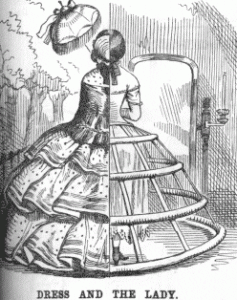In Lee Jackson’s “Dictionary of Victorian London”, the subject of woman and their clothing from the 1800’s struck me as interesting. More specifically, pockets in women’s clothing. Funny enough, as Paris is considered the fashion capital in our modern world, it was considered the same in the Victorian age. And as it is today considered a luxury to have clothing made in Paris, it was then too. Only the finest clothing was made in Paris with the finest jewels and jewelry. “Single girls wore few jewels, and their dresses, although flounced and bulgy, were usually of simple material.” Usually, when a woman was wearing a poor amount of jewelry, this was how it was advertised they were single. Usually, when woman were wed, their husbands would try to dress them in the nicest clothing to prove how they could provide for their wives.
A large staple in woman’s fashion consisted of crinolines which were petticoats made from stiff material. Alfred Rosling Bennett states that, “When ladies had to sit close, as in a train or bus, or pass through a narrow doorway, something had to bulge, and hoops perforce became oval”. The material was so stiff that when standing it created a perfect circle around a lady’s body.

In this time period, Woman would be ostracized if they showed too much skin. Hence, woman were forced to wear these ridiculous outfits with absurd amounts of material. Although, the excessive amount of material did give them one advantage, pockets. Not only did the adult women have pockets but so did the young girls. It was a big deal that woman could have pockets. In the 1800’s, only men’s clothing had pockets which represented superiority, and woman’s clothing now having pockets was considered to be a societal upgrade.
I found it surprising that something as simple as pockets that seems so insignificant, were of huge significance for women of the 1800’s.